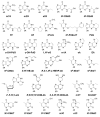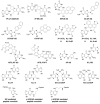Biological Evaluation of DNA Biomarkers in a Chemically Defined and Site-Specific Manner
- PMID: 31242562
- PMCID: PMC6631660
- DOI: 10.3390/toxics7020036
Biological Evaluation of DNA Biomarkers in a Chemically Defined and Site-Specific Manner
Abstract
As described elsewhere in this Special Issue on biomarkers, much progress has been made in the detection of modified DNA within organisms at endogenous and exogenous levels of exposure to chemical species, including putative carcinogens and chemotherapeutic agents. Advances in the detection of damaged or unnatural bases have been able to provide correlations to support or refute hypotheses between the level of exposure to oxidative, alkylative, and other stresses, and the resulting DNA damage (lesion formation). However, such stresses can form a plethora of modified nucleobases, and it is therefore difficult to determine the individual contribution of a particular modification to alter a cell's genetic fate, as measured in the form of toxicity by stalled replication past the damage, by subsequent mutation, and by lesion repair. Chemical incorporation of a modification at a specific site within a vector (site-specific mutagenesis) has been a useful tool to deconvolute what types of damage quantified in biologically relevant systems may lead to toxicity and/or mutagenicity, thereby allowing researchers to focus on the most relevant biomarkers that may impact human health. Here, we will review a sampling of the DNA modifications that have been studied by shuttle vector techniques.
Keywords: DNA adduct bypass; DNA damage; DNA lesion; DNA repair; mutagenicity; mutational signature; mutational spectrum; replication block; shuttle vector technique; site-specific mutagenesis.
Conflict of interest statement
The authors declare no conflict of interest.
Figures






Similar articles
-
Impact of DNA lesion repair, replication and formation on the mutational spectra of environmental carcinogens: Aflatoxin B1 as a case study.DNA Repair (Amst). 2018 Nov;71:12-22. doi: 10.1016/j.dnarep.2018.08.008. Epub 2018 Aug 25. DNA Repair (Amst). 2018. PMID: 30309820 Free PMC article. Review.
-
Cancer risk and oxidative DNA damage in man.J Mol Med (Berl). 1996 Jun;74(6):297-312. doi: 10.1007/BF00207507. J Mol Med (Berl). 1996. PMID: 8862511 Review.
-
Extending the understanding of mutagenicity: structural insights into primer-extension past a benzo[a]pyrene diol epoxide-DNA adduct.J Mol Biol. 2003 Apr 4;327(4):797-818. doi: 10.1016/s0022-2836(03)00187-6. J Mol Biol. 2003. PMID: 12654264
-
Genotoxicity of 1,3-butadiene and its epoxy intermediates.Res Rep Health Eff Inst. 2009 Aug;(144):3-79. Res Rep Health Eff Inst. 2009. PMID: 20017413
-
Mutational spectra for polycyclic aromatic hydrocarbons in the supF target gene.Mutat Res. 2000 May 30;450(1-2):75-93. doi: 10.1016/s0027-5107(00)00017-8. Mutat Res. 2000. PMID: 10838135 Review.
Cited by
-
Synthesis, Biophysical and Biological Evaluation of Splice-Switching Oligonucleotides with Multiple LNA-Phosphothiotriester Backbones.J Am Chem Soc. 2024 Oct 30;146(43):29773-29781. doi: 10.1021/jacs.4c11402. Epub 2024 Oct 14. J Am Chem Soc. 2024. PMID: 39401255 Free PMC article.
-
Biomarkers of Environmental Toxicants: Exposure and Biological Effects.Toxics. 2020 May 22;8(2):37. doi: 10.3390/toxics8020037. Toxics. 2020. PMID: 32456001 Free PMC article.
References
-
- Miller E.C. Some current perspectives on chemical carcinogenesis in humans and experimental animals: Presidential Address. Cancer Res. 1978;38:1479–1496. - PubMed
Publication types
Grants and funding
LinkOut - more resources
Full Text Sources
Research Materials
Miscellaneous

